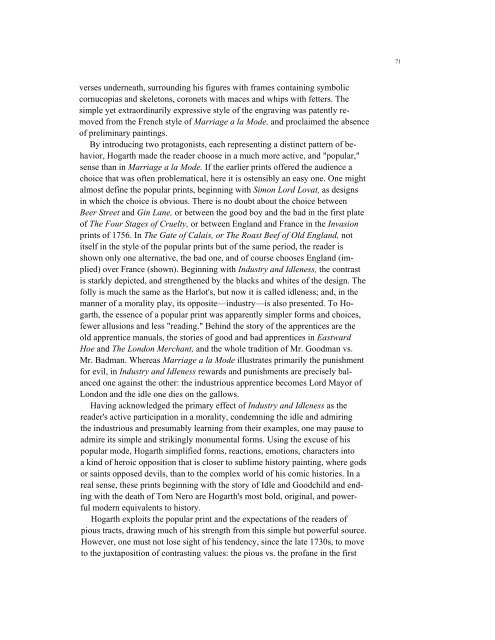Create successful ePaper yourself
Turn your PDF publications into a flip-book with our unique Google optimized e-Paper software.
verses underneath, surrounding his figures with frames containing symbolic<br />
cornucopias <strong>and</strong> skeletons, coronets with maces <strong>and</strong> whips with fetters. The<br />
simple yet extraordinarily expressive style of the engraving was patently re-<br />
moved from the French style of Marriage a la Mode, <strong>and</strong> proclaimed the absence<br />
of preliminary paintings.<br />
By introducing two protagonists, each representing a distinct pattern of be-<br />
havior, <strong>Hogarth</strong> made the reader choose in a much more active, <strong>and</strong> "popular,"<br />
sense than in Marriage a la Mode. If the earlier prints offered the audience a<br />
choice that was often problematical, here it is ostensibly an easy one. One might<br />
almost define the popular prints, beginning with Simon Lord Lovat, as designs<br />
in which the choice is obvious. There is no doubt about the choice between<br />
Beer Street <strong>and</strong> Gin Lane, or between the good boy <strong>and</strong> the bad in the first plate<br />
of The Four Stages of Cruelty, or between Engl<strong>and</strong> <strong>and</strong> France in the Invasion<br />
prints of 1756. In The Gate of Calais, or The Roast Beef of Old Engl<strong>and</strong>, not<br />
itself in the style of the popular prints but of the same period, the reader is<br />
shown only one alternative, the bad one, <strong>and</strong> of course chooses Engl<strong>and</strong> (im-<br />
plied) over France (shown). Beginning with Industry <strong>and</strong> Idleness, the contrast<br />
is starkly depicted, <strong>and</strong> strengthened by the blacks <strong>and</strong> whites of the design. The<br />
folly is much the same as the Harlot's, but now it is called idleness; <strong>and</strong>, in the<br />
manner of a morality play, its opposite—industry—is also presented. To Ho-<br />
garth, the essence of a popular print was apparently simpler forms <strong>and</strong> choices,<br />
fewer allusions <strong>and</strong> less "reading." Behind the story of the apprentices are the<br />
old apprentice manuals, the stories of good <strong>and</strong> bad apprentices in Eastward<br />
Hoe <strong>and</strong> The London Merchant, <strong>and</strong> the whole tradition of Mr. Goodman vs.<br />
Mr. Badman. Whereas Marriage a la Mode illustrates primarily the punishment<br />
for evil, in Industry <strong>and</strong> Idleness rewards <strong>and</strong> punishments are precisely bal-<br />
anced one against the other: the industrious apprentice becomes Lord Mayor of<br />
London <strong>and</strong> the idle one dies on the gallows.<br />
Having acknowledged the primary effect of Industry <strong>and</strong> Idleness as the<br />
reader's active participation in a morality, condemning the idle <strong>and</strong> admiring<br />
the industrious <strong>and</strong> presumably learning from their examples, one may pause to<br />
admire its simple <strong>and</strong> strikingly monumental forms. Using the excuse of his<br />
popular mode, <strong>Hogarth</strong> simplified forms, reactions, emotions, characters into<br />
a kind of heroic opposition that is closer to sublime history painting, where gods<br />
or saints opposed devils, than to the complex world of his comic histories. In a<br />
real sense, these prints beginning with the story of Idle <strong>and</strong> Goodchild <strong>and</strong> end-<br />
ing with the death of Tom Nero are <strong>Hogarth</strong>'s most bold, original, <strong>and</strong> power-<br />
ful modern equivalents to history.<br />
<strong>Hogarth</strong> exploits the popular print <strong>and</strong> the expectations of the readers of<br />
pious tracts, drawing much of his strength from this simple but powerful source.<br />
However, one must not lose sight of his tendency, since the late 1730s, to move<br />
to the juxtaposition of contrasting values: the pious vs. the profane in the first<br />
71
















